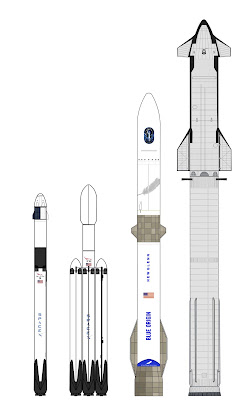Finally some real competition for SpaceX?
Amid all the excitement of the last while I wanted to highlight one bit of good news. Last week a bunch of stuff happened with regard to space launches. Some bad as well with SpaceX's Starship exploded spectacularly (seriously watch if you haven't seen it). They're still sort of supposed to be exploding at this point in testing but it exploded much earlier than expected and the danger of debris meant some flights had to be diverted. But we had a couple more landers heading off to the Moon. We had a fun re-entry science mission. And we had Blue Origin's long awaited New Glenn launched for the first time and get right to its target orbit.
Blue Origin is a company that actually started slightly earlier than SpaceX but never had the other's sense of urgency. Instead its motto has been “Gradatim ferociter” or "step by step, ferociously" with turtles reaching towards space on the original logo. The company had spent a lot of time doing suborbital hops instead of aiming straight for orbit like SpaceX did.
Lets say you want to go to GEostationary Orbit (GEO) instead. For there the Falcon 9 can haul 5.5 tons and New Glenn 13.6 tons. That's a bit of a better ratio than LEO and that's because New Glenn uses a hydrogen second stage while SpaceX uses the same kerosene fuel it uses in the first stage. As I mentioned way back in my post series on rockets that to reach higher velocities it's easier to increase the exhaust velocity by the same amount rather than having to increase the ratio of fuel to payload exponentially. Kerosene is dense and it's easier to get a good mass ratio but the propellant travels more slowly. Together that means that as the final target speed gets faster hydrogen tends to do better. Another way of looking at it is that as the speed of a rocket gets closer to the speed of the propellant more of the energy produced ends up in the rocket rather than the propellant.
But the bottom line is that New Glenn can get more than twice as much stuff to space per launch as SpaceX can. The thing is, though, that New Glenn is apparently going to sell launches for $110 million each while SpaceX's commercial prices are currently $67 million, a lot less than a factor of 2.5.
Now, SpaceX can go lower. Rumor is it takes them about $15 million to launch a rocket that lets them re-use the faring and booster. But they've been raking the money in for each launch until now and if they actually end up having some competition they'll have to finally cut prices and make space cheaper for everyone else who wants to do interesting things there. I have no idea how much New Glenn costs and it's possible that with Jeff Bezos's deep pockets they're actually selling each launch at a loss right now. In fact given the loss of the booster that's a near certainty. And that isn't the whole story either, SpaceX has a very long track record now and while they did eventually have a third launch failure with launch 354, well, they had had hundreds of successful launches before that. New Glenn, by contrast, has exactly one successful launch so far and realistically is probably going to lose at least one of the next ten.
But as Blue starts landing boosters and gets the bugs shaken out I really think that SpaceX is going to have to start cutting prices to compete, good news for everyone else who wants to put stuff into space.



Comments
Post a Comment